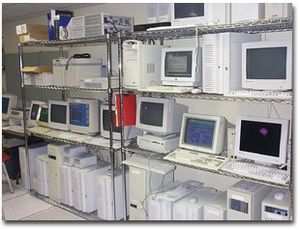Difference between revisions of "Server Build"
(trim out useless links) |
(→Server Quality Control Steps: added server spec label) |
||
| Line 43: | Line 43: | ||
* boots without keyboard | * boots without keyboard | ||
* automatically boots after power loss | * automatically boots after power loss | ||
| + | * ensure server specs label contains accurate information: | ||
| + | ** processor speed (GHz) and type (Xeon, AMD Opteron, P4) | ||
| + | ** number of physical processors | ||
| + | ** number and type (DDR, DDR2) of ram slots | ||
| + | ** number, size (MB or GB), and type (i.e. PC2100 ECC Registered) of individual ram sticks | ||
| + | ** total ram included (i.e. 6GB) | ||
| + | ** number of likely hard drive bays | ||
| + | ** types of hard drive ports (ide, sata, scsi) | ||
| + | ** put system id in other section | ||
=Info= | =Info= | ||
Revision as of 12:56, 1 September 2010
Server/Enterprise PROGRAM at Free Geek
The Program
Server Build evaluates and builds, well, servers. Servers are simply computers that tend to have higher quality parts, hot-swappable power supplies, hot swappable hard drives, or fit into server racks.
Class Times
- Wednesdays 11-2:45 and 3-6:45.
Steps
The Server Build program requires a great deal of pc hardware experience, so it is expected that all students have gone through the Build program before moving into the Server Build program.
Server evaluation: determine basic specs such as processor(s) type and speed, hard drive bays, ram type, etc.
Server build: build out systems that meet criteria for use in infrastructure, hardware grants or the thrift store.
Quality control: ensure that systems already built can read CDs, USB ports work, boot fine, etc.
In addition, there are some tasks that can be done throughout your time in the project:
- ram sorting
- shelf organizing
Server Build Steps
- Install Debian Lenny Server via PXE Boot
- Make sure it boots properly
- Run Memtest
Server Quality Control Steps
- remove sata drives
- run printme
- boot from network
- select fat client (printme)
- click log in as guest
- open a terminal
- run printme
- put system id on server specs sticker (in other section)
- put tower or rackmount size (1U, 2U, 3U, 4U, etc.) in printme notes
- check that it boots from CD
- test USB ports (front and back)
- test video ports (front and back)
- boots without keyboard
- automatically boots after power loss
- ensure server specs label contains accurate information:
- processor speed (GHz) and type (Xeon, AMD Opteron, P4)
- number of physical processors
- number and type (DDR, DDR2) of ram slots
- number, size (MB or GB), and type (i.e. PC2100 ECC Registered) of individual ram sticks
- total ram included (i.e. 6GB)
- number of likely hard drive bays
- types of hard drive ports (ide, sata, scsi)
- put system id in other section
Info
Here's the howtos and information we need to accomplish our tasks.
- Entering BIOS
- Server System Disassembly
- Server Hard Drive Removal
- Server Service Manuals
- Server Memory
- CD DVD & External drives
Links
These are mostly pages full of links to other place:
- OS X86 Links
- http://www.networkdictionary.com/hardware/server.php
- http://ultimatebootcd.com/
- http://www.streambench.org/
- http://www.freebench.org/
- http://www.tux.org/˜mayer/linux/bmark.html
- http://www.acnc.com/benchmarks.html
- http://www.netlib.org/benchmark/hpl/
- http://lbs.sourceforge.net/ - Linux Benchmark Suite Homepage
ToDo:
- syllabus, repair howto(s) & triage charts, wiki
